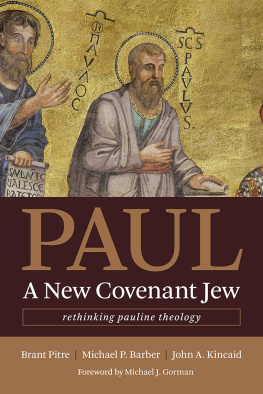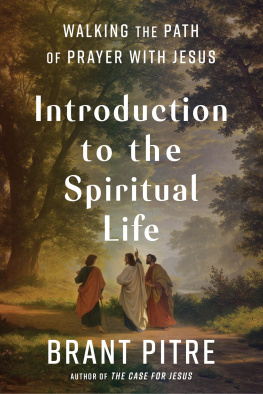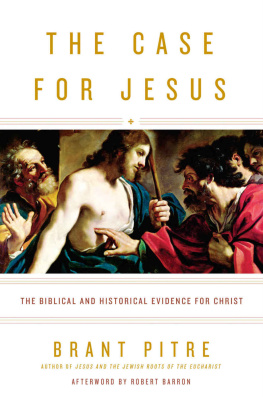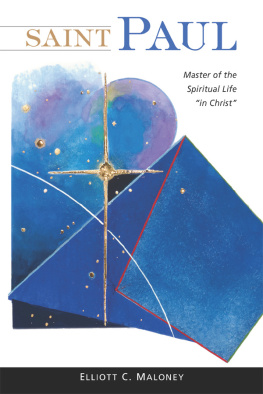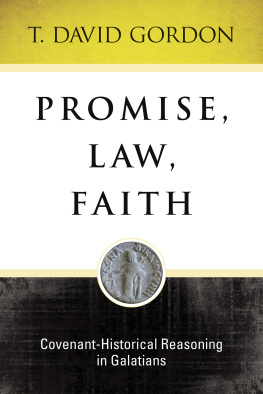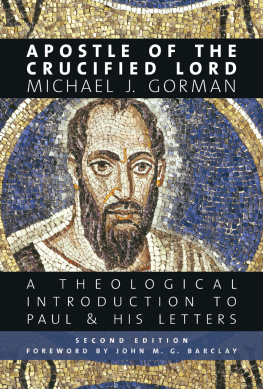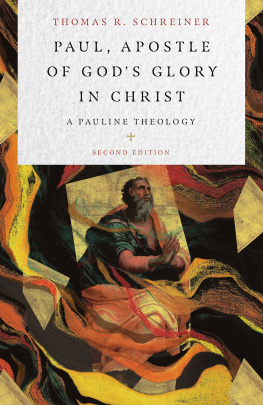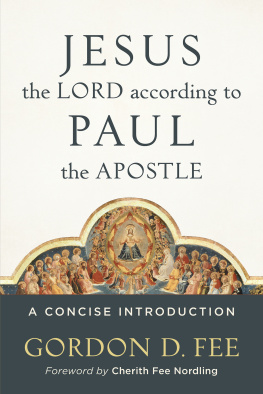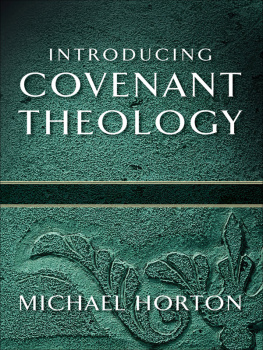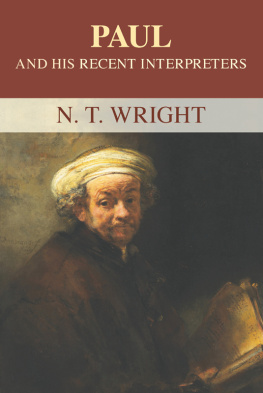A helpful synthesis of themes in Pauline theology that reveals connections with one another and with Old Testament precedents. Many of these insights will resonate with Protestant as well as Catholic exegetes, and Protestants such as myself will find these authors gracious, worthy, and willing conversation partners.
CRAIG S. KEENER,
Asbury Theological Seminary
The world of biblical studies and Pauline theology has been waiting a generation for this book. Covering a wide range of major issues, while engaging the wide spectrum of current perspectives, this is a major contribution to Pauline scholarship from three outstanding Catholic scholarswell worth the wait.
SCOTT HAHN,
Franciscan University of Steubenville
Pitre, Barber, and Kincaid persuasively argue that Paul was a new covenant Jew, an approach that proves to be a convincing way of describing the continuities between Paul and Judaism as well as the discontinuities that emerge out of Pauls explicit christological recasting of the Jewish worldview. In a deliciously ecumenical approach, their vision of Paul brings together various threads of Jewish apocalypticism, Pauls core conviction about Jesus, his account of the cross and justification, as well as new creation and communion. A genuinely fresh and insightful study of Paul that all serious students of the Bible will need to read.
MICHAEL F. BIRD,
Ridley College
This synthetic work is a goldmine for scholars and students alike. Drawing upon the full range of contemporary Pauline scholarship, the authors carefully and generously describe the positions that differ from their own, thereby enabling beginning students to get their bearings in the debates. At the same time, scholars will be enthralled by the nuanced, rigorous, and serene case they make for overcoming well-known polarities in Pauline studies. They present a Paul who joyfully proclaims the new covenant in Christ Jesus, with implications for sonship, faith, baptism, grace, atonement, justification, Israel, the Eucharist, and much more. Not only for biblical scholars, but also for theologians, this spectacular scholarly study is a must read.
MATTHEW LEVERING,
Mundelein Seminary
As the scholarly guild continues to churn out monographs on St. Paul and his writings, it is rare to read one that proposes a truly fresh perspective. Brant Pitre, Michael Barber, and John Kincaid, however, have managed to write just such a book. Their proposal that Paul is best described as a new covenant Jew (because he himself does so!) allows them to capture both points of continuity with prior Jewish traditions as well as the novum of Pauls gospel concerning the crucified-and-risen Jesus. Their Catholic both-and approach, done with sound exegetical argumentation and wide consultation with the best of contemporary scholarship, enables them to set forth the coherence of Pauls theological vision. I highly recommend this volume and will use it in my teaching.
THOMAS D. STEGMAN, SJ,
Boston College School of Theology and Ministry
While a lot is published on Paul, much of it is regurgitated and mundane, a mere reshuffling of the same worn furnitureand my eyes glaze. Others, however, try so hard to push the boat out and become polemical that my eyes roll. Not many manage to negotiate the waters between Scylla and Charybdis, but you are holding one that does! Its a riveting read that presents answers to conundrums that are jarring in their economy, elegance, and power. Presented with a contagious verve and enthusiasm, these three brilliant young scholars weave cutting-edge and up-to-date scholarship into a highly readable tapestry. No stodgy, tired, overly pompous detail. No academic posturing. You are presented with fresh ideas, new proposals, and its all delivered at just the right pace. Its a truly enjoyable read that deserves much critical meditation. So in short: the time you give to reading this book will be time very well spent. Even where questions remain, I know that Ive learned much from them; Ive glimpsed things that were previously hidden from me. In this presentation of Paul as a new covenant Jew, the Apostle might just burst out of his letters afresh. This is Paul the pop-up book!
CHRIS TILLING, St. Mellitus College
Paul, a New Covenant Jew
Rethinking Pauline Theology
Brant Pitre, Michael P. Barber, and John A. Kincaid
WILLIAM B. EERDMANS PUBLISHING COMPANY
GRAND RAPIDS, MICHIGAN
Wm. B. Eerdmans Publishing Co.
4035 Park East Court SE, Grand Rapids, Michigan 49546
www.eerdmans.com
2019 Brant Pitre, Michael P. Barber, and John A. Kincaid
All rights reserved
Published 2019
252423222120191234567
ISBN 978-0-8028-7376-7
eISBN 978-1-4674-5703-3
Library of Congress Cataloging-in-Publication Data
A catalog record for this book is available from the Library of Congress.
Unless otherwise noted, Scripture quotations are from the New Revised Standard Version of the Bible, copyright 1989 by the Division of Christian Education of the National Council of the Churches of Christ in the U.S.A., and used by permission.
To Elizabeth, Kimberly, and Kristen,
who continually teach us what the apostle Paul meant when he said,
Love is patient; love is kind.... Love never ends (1 Cor 13:4, 8)
CONTENTS
The unique book you are about to read interprets Paul within at least three significant contexts: the Jewish world of the first century, the world of ecumenical and interfaith biblical scholarship, and the world of Roman Catholic faith and practice. In a similar yet different way, these are also my worlds, even though I am a Protestant rather than a Catholic. For more than a quarter century, I have taught the New Testament, and especially the apostle Paul, at the oldest Catholic seminary in the United States and the only one in the world (as far as we know) that has an ecumenical graduate theological school within the institution: St. Marys Ecumenical Institute. Because the authors worlds and mine overlap, I am especially happy to introduce and commend this volume.
Each of these three worlds is important to the books three authors: Brant Pitre, Michael Barber, and John Kincaid. In a way, however, it may be their shared Catholic faith that leads them so fully into the other two worlds. Indeed, what stands out most about this book is not so much its particular Catholic perspectives on Pauline theologythough they are presentbut rather its deep immersion in the other two worlds. Allow me to explain.
For Pitre, Barber, and Kincaid, Paul is simply incomprehensible without reference to the scriptures of Israel and Second Temple Judaism. That is why the book constantly discusses Jewish thought and praxis, citing scriptural and other texts, and showing us both where Paul resonates with certain ideas and practices and where he goes his own way in light of Jesus the Messiah and Lord. In particular, Pitre, Barber, and Kincaid proposerightly, in my viewthat Paul is a new covenant Jew. Still more specifically, they argue that Paul proclaims the apocalyptic new covenant: something that is earth-shatteringly new while simultaneously fulfilling ancient Jewish hopes and divine promises. Again, I think this thesis is precisely correct.
This approach to Paul situates the authors solidly within the field of Pauline studies, in which everyone agrees that Paul is a Second Temple Jew and yet there is debate about what kind of Jew he was. Pitre, Barber, and Kincaid have been heavily influenced by certain scholars who have also emphasized some of the key dimensions of Paul that they stress. These scholarly siblings include, of course, some fellow Roman Catholic scholars such as Frank Matera, Joseph Fitzmyer, Scott Hahn, and Thomas Stegman. Yet the most frequently cited scholars in the book are not Catholic: E. P. Sanders, N. T. Wright, James Dunn, Richard Hays, and the present writer.

